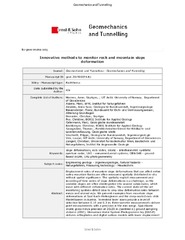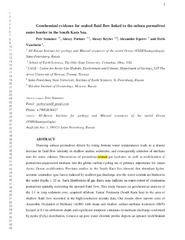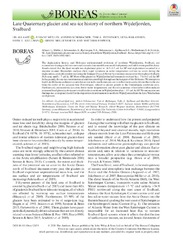Artikler, rapporter og annet (geovitenskap): Recent submissions
Now showing items 461-480 of 825
-
Innovative methods to monitor rock and mountain slope deformation
(Journal article; Tidsskriftartikkel; Peer reviewed, 2020-02-17)Displacement rates of mountain slope deformations that can affect entire valley mountain flanks are often measured spatially distributed in‐situ without spatial significance. The spatially explicit measurement and recording of time series of slope deformations is a challenge, as the unstable slopes are often disintegrated into several subdomains, which move with different deformation rates. The ... -
Geochemical evidence for seabed fluid flow linked to the subsea permafrost outer border in the South Kara Sea
(Journal article; Tidsskriftartikkel; Peer reviewed, 2019-04-16)Driven by rising bottom water temperatures, the thawing of subsea permafrost leads to an increase in fluid flow intensity in shallow marine sediments and results in the emission of methane into the water column. Limiting the release of permafrost-related gas hydrates and permafrost- sequestered methane into the global carbon cycle are of primary importance to the prevention of future Arctic Ocean ... -
Late Quaternary glacier and sea-ice history of northern Wijdefjorden, Svalbard
(Journal article; Tidsskriftartikkel; Peer reviewed, 2020-04-10)The deglaciation history and Holocene environmental evolution of northern Wijdefjorden, Svalbard, are reconstructed using sediment cores and acoustic data (multibeam swath bathymetry and sub‐bottom profiler data). Results reveal that the fjord mouth was deglaciated prior to 14.5±0.3 cal. ka BP and deglaciation occurred stepwise. Biomarker analyses show rapid variations in water temperature and sea ... -
Global temperature calibration of the Long chain Diol Index in marine surface sediments
(Journal article; Tidsskriftartikkel; Peer reviewed, 2020-02-07)The Long chain Diol Index (LDI) is a relatively new organic geochemical proxy for sea surface temperature (SST), based on the abundance of the C<sub>30</sub> 1,15-diol relative to the summed abundance of the C<sub>28</sub> 1,13-, C<sub>30</sub> 1,13- and C<sub>30</sub> 1,15-diols. Here we substantially extend and re-evaluate the initial core top calibration by combining the original dataset with 172 ... -
Late Devonian–Carboniferous faulting and controlling structures and fabrics in NW Finnmark
(Journal article; Tidsskriftartikkel; Peer reviewed, 2019-09-10)In the SW Barents Sea, Devonian–Carboniferous collapse led to the formation of major basins and faults, e.g., the Hammerfest Basin bounded by the Troms–Finnmark Fault Complex, and rhomboid- to sigma-shaped (half-)grabens on the Finnmark Platform. High-resolution aeromagnetic and bathymetry data from the shallow shelf show that analogue fault systems are present in coastal and onshore areas of NW ... -
Microbial communities from Arctic marine sedimentsrespond slowly to methane addition duringex situenrichments
(Journal article; Tidsskriftartikkel; Peer reviewed, 2019-12-15)Anaerobic methanotrophic archaea (ANME) consume methane in marine sediments, limiting its release to the water column, but their responses to changes in methane and sulfate supplies remain poorly constrained. To address how methane exposure may affect microbial communities and methane‐ and sulfur‐cycling gene abundances in Arctic marine sediments, we collected sediments from offshore Svalbard that ... -
Geological controls of giant crater development on the Arctic seafloor
(Journal article; Tidsskriftartikkel; Peer reviewed, 2020-05-21)Active methane seepage occurs congruent with a high density of up to 1 km-wide and 35 m deep seafloor craters (>100 craters within 700 km<sup>2</sup> area) within lithified sedimentary rocks in the northern Barents Sea. The crater origin has been hypothesized to be related to rapid gas hydrate dissociation and methane release around 15–12 ka BP, but the geological setting that enabled and possibly ... -
Is there a Climatic Control on Icelandic Volcanism?
(Journal article; Tidsskriftartikkel; Peer reviewed, 2020-05-07)The evidence for periods of increased volcanic activity following deglaciation, such as following ice sheet retreat after the Last Glacial Maximum, has been examined in several formerly glaciated areas, including Iceland, Alaska, and the Andean Southern Volcanic Zone. Here we present new evidence supporting the theory that during episodes of cooling in the Holocene, Icelandic volcanic activity ... -
Biogeochemical Consequences of Nonvertical Methane Transport in Sediment Offshore Northwestern Svalbard
(Journal article; Tidsskriftartikkel; Peer reviewed, 2020-03-21)A site at the gas hydrate stability limit was investigated offshore northwestern Svalbard to study methane transport in sediment. The site was characterized by chemosynthetic communities (sulfur bacteria mats, tubeworms) and gas venting. Sediments were sampled with in situ porewater collectors and by gravity coring followed by analyses of porewater constituents, sediment and carbonate geochemistry, ... -
Structurally controlled rock slope deformation in northern Norway
(Journal article; Tidsskriftartikkel; Peer reviewed, 2020-05-11)Gravitational forcing of oversteepened rock mass leads to progressive failure, including rupture, creeping, sliding and eventual avalanching of the unstable mass. As the point of rupture initiation typically follows pre-existing structural discontinuities within the rock mass, understanding the structural setting of slopes is necessary for an accurate characterisation of the hazards and estimation ... -
The role of deformation-reaction interactions to localize strain in polymineralic rocks: Insights from experimentally deformed plagioclase-pyroxene assemblages
(Journal article; Tidsskriftartikkel; Peer reviewed, 2020-02-09)In order to study the mutual effect of deformation and mineral reactions, we have conducted shear experiments on fine-grained plagioclase-pyroxene assemblages in a Griggs-type solid-medium deformation apparatus. Experiments were performed at a constant shear strain rate of 10<sup>−5</sup> s<sup>−1</sup>, a confining pressure of 1 GPa and temperatures of 800, 850 and 900 °C. While the peak stress of ... -
Deciphering late Devonian–early Carboniferous P–T–t path of mylonitized garnet-mica schists from Prins Karls Forland, Svalbard
(Journal article; Tidsskriftartikkel; Peer reviewed, 2020-03-03)Quartz‐in‐garnet inclusion barometry integrated with trace element thermometry and calculated phase relations is applied to mylonitized schists of the Pinkie unit cropping out on the island of Prins Karls Forland, western part of the Svalbard Archipelago. This approach combines conventional and novel techniques and allows deciphering of the pressure–temperature (<i>P–T</i>) evolution of mylonitic ... -
Manganese/iron‐supported sulfate‐dependent anaerobic oxidation of methane by archaea in lake sediments
(Journal article; Tidsskriftartikkel; Peer reviewed, 2019-11-04)Anaerobic oxidation of methane (AOM) by methanotrophic archaea is an important sink of this greenhouse gas in marine sediments. However, evidence for AOM in freshwater habitats is rare, and little is known about the pathways, electron acceptors, and microbes involved. Here, we show that AOM occurs in anoxic sediments of a sulfate‐rich lake in southern Switzerland (Lake Cadagno). Combined AOM‐rate ... -
Estimation of net apparent erosion in the SW Barents Sea by applying velocity inversion analysis
(Journal article; Tidsskriftartikkel; Peer reviewed, 2019)The SW Barents Sea was subjected to significant uplift and erosion during the Cenozoic, processes that are believed to have had a significant impact on hydrocarbon maturation and migration in the area. The current study uses compaction of shale- and sand-dominated layers to make a map of net apparent erosion throughout the SW Barents Sea. The map shows regional trends consistent with deep-seated ... -
The Lomfjorden Fault Zone in eastern Spitsbergen (Svalbard)
(Journal article; Tidsskriftartikkel; Peer reviewed, 2019-06-14)The Lomfjorden Fault Zone in the eastern part of Spitsbergen is one of the prominent structures in Svalbard oriented parallel to the continental margin of the Barents Shelf. It consists of a network of three N–S-striking major faults (Veteranen, Lomfjorden, and Agardhbukta faults), two N–S-striking reverse faults (Lomfjella and Bjørnfjellet reverse faults), and a number of NE–SW- and NNW–SSE-striking ... -
Foraminiferal δ18O reveals gas hydrate dissociation in Arctic and North Atlantic ocean sediments
(Journal article; Tidsskriftartikkel; Peer reviewed, 2020-01-07)Paleoceanographic investigations in the Arctic and north Atlantic are crucial to understanding past and current climate change, in particular considering amounts of pressure-temperature sensitive gas stored in marine sediments of the region. Many paleoceanographic studies are based on foraminiferal oxygen and carbon stable isotope compositions (δ<sup>18</sup>O, δ<sup>13</sup>C) from either planktonic ... -
Icelandic permafrost dynamics since the Last Glacial Maximum – model results and geomorphological implications
(Journal article; Tidsskriftartikkel; Peer reviewed, 2020-03-14)Iceland’s periglacial realm is one of the most dynamic on the planet, with active geomorphologicalprocesses and high weathering rates of young bedrock resulting in high sediment yields and ongoingmass movement. Permafrost is discontinuous in Iceland’s highlands and mountains over c. 800 m a.s.l,and sporadic in palsa mires in the central highlands. During the late Pleistocene and Holocene, ... -
Iron cycling in Arctic methane seeps
(Journal article; Tidsskriftartikkel; Peer reviewed, 2020-03-26)Anoxic marine sediments contribute a significant amount of dissolved iron (Fe<sup>2+</sup>) to the ocean which is crucial for the global carbon cycle. Here, we investigate iron cycling in four Arctic cold seeps where sediments are anoxic and sulfidic due to the high rates of methane-fueled sulfate reduction. We estimated Fe<sup>2+</sup> diffusive fluxes towards the oxic sediment layer to be in the ... -
Deglacial–Holocene Svalbard paleoceanography and evidence of Melt Water Pulse 1B
(Journal article; Tidsskriftartikkel; Peer reviewed, 2020-03-09)Better understanding of deglacial meltwater pulses (MWPs) is imperative for future predictions of human-induced warming and abrupt sea-level change because of their potential for catastrophic damage. However, our knowledge of the second largest meltwater pulse MWP-1B that occurred shortly after the start of the Holocene interglacial remains very limited. Here, we studied fossil ostracods as ... -
Seismic on floating ice: data acquisition versus flexural wave noise
(Journal article; Tidsskriftartikkel; Peer reviewed, 2019-02-09)Geophysical surveying of the Arctic will become increasingly important in future prospecting and monitoring of the terrestrial and adjacent areas in this hemisphere. Seismic data acquired on floating ice are hampered with extensive noise due to ice vibrations related to highly dispersive ice flexural waves generated by the seismic source. Several experiments have been conducted on floating ice in ...


 English
English norsk
norsk


















